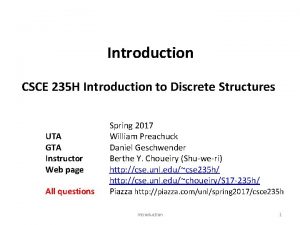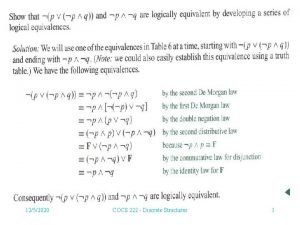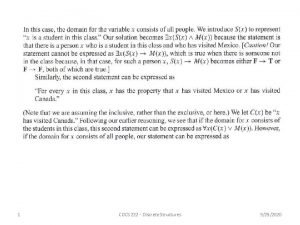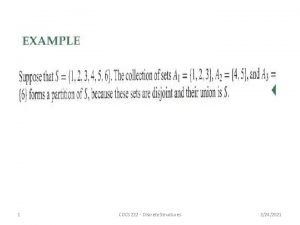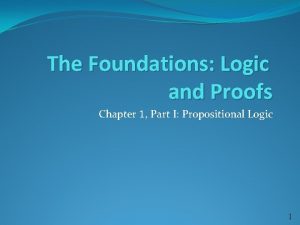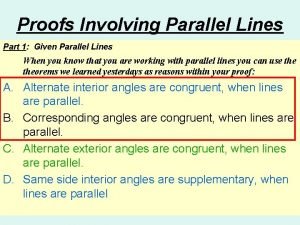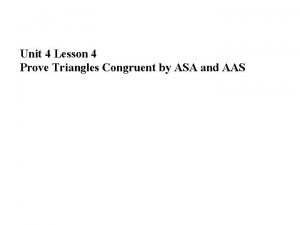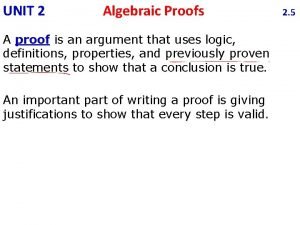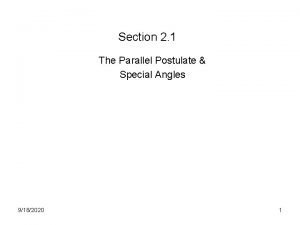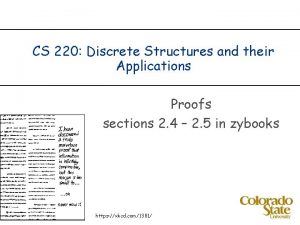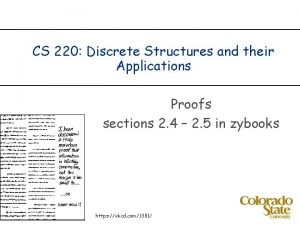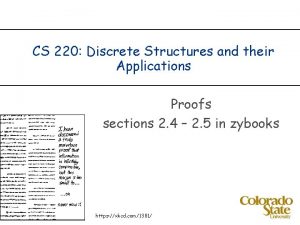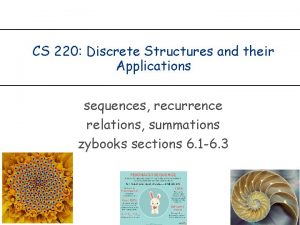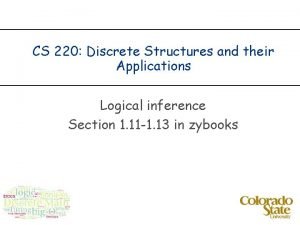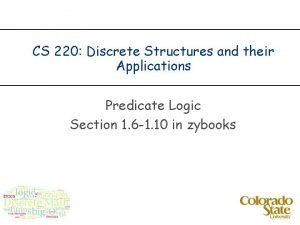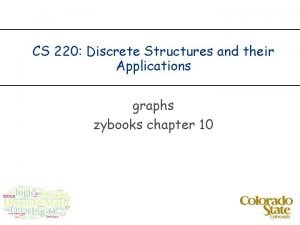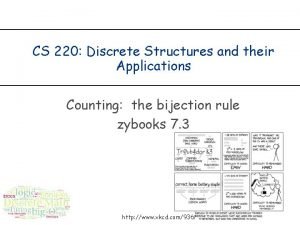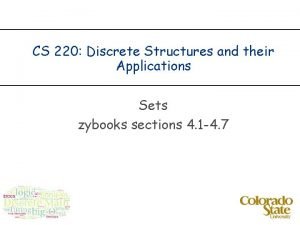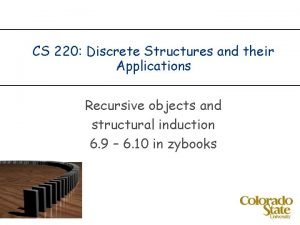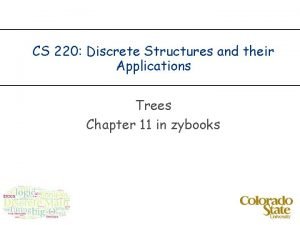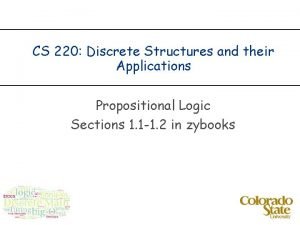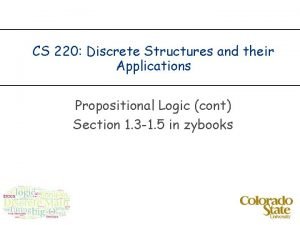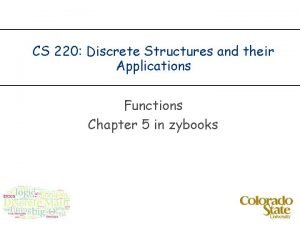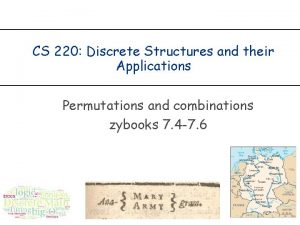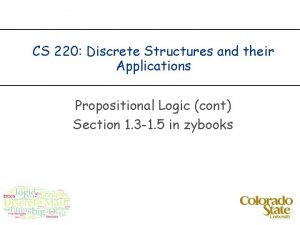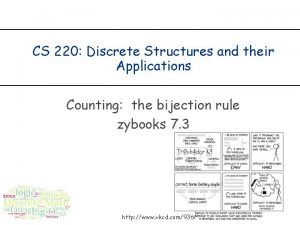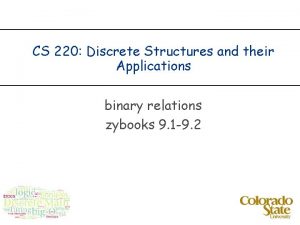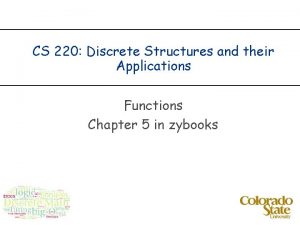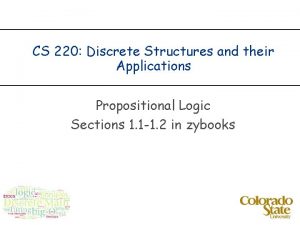CS 220 Discrete Structures and their Applications Proofs























- Slides: 23

CS 220: Discrete Structures and their Applications Proofs sections 2. 1 -2. 3 in zybooks https: //xkcd. com/1381/

Fermat’s last theorem Theorem: For every integer n > 2 there is no solution to the equation an + bn = cn where a, b, and c are positive integers

Terminology Theorem: statement that can be shown to be true Proof: a valid argument that establishes the truth of a theorem Conjecture: statement believed to be a true

Example Goldbach’s conjecture: “Every even integer greater than 2 can be written as the sum of two primes” Image from https: //en. wikipedia. org/wiki/Goldbach%27 s_conjecture

Proofs What is a proof A valid argument that establishes the truth of a mathematical statement The rules of inference we saw: All the steps and rules were provided Not practical: formal proofs of useful theorems are long. In practice: ”informal proofs” (good for human consumption) n n n We will see methods for constructing proofs

Theorems Theorem: If x is a positive integer, then x ≤ x 2. What is meant is: For all positive integers x ≤ x 2. Many theorems are universal statements.

Theorems Theorem: If x is a positive integer, then x ≤ x 2. What is meant is: For all positive integers x ≤ x 2. Many theorems are universal statements. And some theorems can be universal statements over multiple variables with different domains: Theorem: If x and y are positive real numbers and n is a positive integer, then (x + y)n ≥ xn + yn.

Proofs Theorem: If x is a positive integer, then x ≤ x 2. Proof. Let x be a positive integer, i. e. x > 0. Name a generic object in the domain and give assumptions about the object Since x is an integer and x > 0, x ≥ 1 Since x > 0, we can multiply both sides of the inequality by x to get: x*x≥ 1*x Simplifying the expression: x 2 ≥ x ■ End of proof symbol

Proof by exhaustion If the domain of a universal statement is small, then all elements can be exhaustively checked. Theorem: If n ∈ {-1, 0, 1}, then n 2 = |n|. Proof. Check the equality for each possible value of n: ü n = -1: (-1)2 = 1 = |-1|. ü n = 0: (0)2 = 0 = |0|. ü n = 1: (1)2 = 1 = |1|. ■

Counterexamples Consider the following statement: If n is an integer greater than 1, then (1. 1)n < n 10. Is it true? Let’s check some values… n=2: (1. 1)2=1. 21<1024=210. n=100: (1. 1)100≈13780. 61<10000000000=10010. We might be tempted to think that this is true for all n.

Counterexamples Consider the following statement: If n is an integer greater than 1, then (1. 1)n < n 10. Is it true? Let’s check some values… n=2: (1. 1)2=1. 21<1024=210. n=100: (1. 1)100≈13780. 61<10000000000=10010. However: (1. 1)686>(686)10.

Counterexamples What is the counterexample for the following statement: The multiplicative inverse of a real number x, is a real number y such that xy = 1. Every real number has a multiplicative inverse.

Counterexamples Once we found a counterexample, we can sometimes fix the statement into a provable theorem: Theorem: Let x be a real number such that x ≠ 0, then there is a real number y such that xy = 1. e. g. statement if n is an odd integer then n*n is even counter example 1*1 = 1 is not even but we cannot fix the statement to make it true WHY?

Proof techniques: ² ² ² Direct proof Proof by contrapositive Proof by contradiction Proof by cases Proof by induction – later in the course

direct proof Want to prove a statement of the form First step: assume p q p is true Next steps: apply inference rules using hypotheses and previously proven theorems Proceed until q is shown to be true

Example Theorem: For every integer n, if n is odd, then n 2 is odd. Definition: an integer n is even if there exists an integer k such that n = 2 k, and n is odd if there exists an integer k such that n = 2 k + 1.

Example Theorem: For every integer n, if n is odd, then n 2 is odd. Proof. If n is odd, then n = 2 k+1 for some integer k. n n 2 = (2 k+1)2 = 4 k 2 + 4 k +1 apply definition of “odd” Therefore, n 2 = 2(2 k 2 + 2 k) + 1, which is odd number from definition – found k such that n 2 = 2 k + 1

Proof by contrapositive A proof by contrapositive proves a conditional theorem of the form p → c by showing that the contrapositive ¬c → ¬p is true. ü ü Based on the logical equivalence of p c and c p Proceeds by assuming c and using the same method as direct proof, showing that p

Example Prove “If n is an integer and 3 n + 2 is odd then n is odd. ” Proof by contrapositive. Suppose the conclusion is false, i. e. n is even. We need to show that 3 n + 2 is even. Then by the definition of an even integer, n = 2 k for some integer k Therefore 3 n + 2 = 3(2 k) + 2 = 6 k + 2 = 2(3 k + 1) Hence, 3 n + 2 is even. n n n Can you produce a direct proof?

Example Theorem: For every integer x, if x 2 is even, then x is even. n n Which proof technique? Direct proof – express x 2 as 2 k for some k, i. e. x = √(2 k) – Not n clear that sqrt(2 k) is an even integer, or even an integer Proof by contrapositive – prove that if x is odd then x 2 is odd

Example Theorem: For every integer x, if x 2 is even, then x is even. Proof by contrapositive. Suppose the conclusion is false, i. e. x is odd. We need to prove that x 2 is odd. Then by the definition of an odd integer, x = 2 k + 1 for some integer k Therefore x 2=(2 k+1)2=4 k 2+4 k+1=2(2 k 2+2 k)+1. Therefore x 2 can be expressed as 2 k' + 1, where k' = 2 k 2 + 2 k is an integer. n n n Hence, x 2 is odd. ■

Example Theorem: For every positive real number r, if r is irrational, then √r is also irrational. Proof by contrapositive. Let r be a positive real number. We assume that √r is not irrational and prove that r is not irrational. Since √r is not irrational and is real, then √r must be a rational number. Therefore √r=x/y for two integers, x and y, where y ≠ 0. Squaring both sides of the equation gives: (√r)2=r=x 2/y 2. We expressed r as the ratio of two integers, so r is a rational number. Therefore r is not irrational. ■

Example Consider the following statement: If x and y are real numbers and x + y is irrational, then x is irrational or y is irrational. What is the contrapositive?
 Lesson 10 unknown angle proofs
Lesson 10 unknown angle proofs Lesson 9 unknown angle proofs—writing proofs
Lesson 9 unknown angle proofs—writing proofs Examples of homologous
Examples of homologous What are ps and qs
What are ps and qs 2110200
2110200 Discrete math
Discrete math Discrete computational structures
Discrete computational structures Discrete structures
Discrete structures Discrete structures
Discrete structures Discrete structures
Discrete structures Propositional logic puzzles
Propositional logic puzzles Susanna s epp
Susanna s epp Application of relation
Application of relation Expander graphs and their applications
Expander graphs and their applications Which insulating material is used in circuit breaker
Which insulating material is used in circuit breaker The foundations logic and proofs
The foundations logic and proofs Proofs of work and bread pudding protocols
Proofs of work and bread pudding protocols Parallel lines proofs practice
Parallel lines proofs practice Paragraph proofs geometry
Paragraph proofs geometry Unit 4 homework 4 congruent triangles
Unit 4 homework 4 congruent triangles Statements and reason
Statements and reason Unit 2 homework 6 algebraic proof
Unit 2 homework 6 algebraic proof Continued proofs transversals and special angles
Continued proofs transversals and special angles





